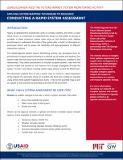| dc.description.abstract | Nearly all development practitioners work in complex systems, and when a major shock occurs, it is important to understand the impact on the system as quickly as possible. In these situations, system maps serve as vital decision tools, helping practitioners to understand the state of the system after a shock (or throughout a prolonged shock) and to assess the feasibility and appropriateness of different intervention options. The USAID/Uganda Market System Monitoring Activity has developed tools for practitioners to apply systems thinking to a diverse set of sectors and systems. Our system maps are built around an intuitive framework of behaviors, conditions, and relationships. They allow practitioners to visualize complex systems, track how the systems adapt and transform, and measure how change propagates through the system. To learn more about creating system maps, please contact the MSM team. This document explains how to use a system map to conduct a rapid assessment of the impact of a particular shock on a system. We have also created an example using a free online system mapping tool, Kumu – links to this example map as well as a guide to the example are provided at the end of the document. | en_US |
